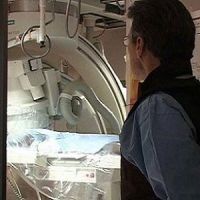A hotelier shares his thoughts on customer service in an article recently published in the Journal of the American College of Radiology. The article is based on a lecture given by Mr. Horst H. Schulze on how a business or organisation can optimise service for their customers. Schulze currently serves as the chairman and chief executive officer of Capella Hotels and Resorts and Solis Hotels and Resorts. His talk is part of a series of lectures organised by the Department of Radiology of Johns Hopkins University.
Hotels and hospitals both share a primary goal of serving the customer. A hospital may be composed of some of the best physicians in the world who may know more about medicine than some of their peers in other hospitals, but that does not necessarily matter. If a hospital does not understand how to optimise service for its customers (i.e., patients), all the medical knowledge in the world will not be sufficient for the business to succeed.
There are three things customers expect from any business: (1) timely service, (2) a good product, and (3) people who treat customers well and are nice to them (i.e., caring service).
Today’s customers are no longer willing to wait for anything. Unfortunately, long wait times seem to be common at many hospitals. Why? The last people who should be kept waiting are sick patients, who are scared and anxious.
How do business owners and managers create an environment in which customers are given timely, satisfactory, and courteous service? They have to hire the right people and give their employees a chance to work in an environment of belonging and purpose.
Many people hire employees by saying that each employee was brought in to fulfil a certain “purpose.” According to Schulze, "I can think of no more dehumanising and immoral statement than this, as it reduces the employee to the status of a machine or automaton. I hire my employees as human beings to join us and be a part of us. I want them to be a part of the vision and dream of our company, and I want them to gain happiness from being part of a team that creates excellence."
In addition, the success of the team and individual employees is highly contingent on having the organisation filled with leaders rather than managers. Leaders give no excuses — they exude positivity, optimism, and drive, and that filters down to every member of the organisation.
Managers, on the other hand, are concerned with covering up their own lack of drive and ambition with excuses.
Elliot K. Fishman, MD, Karen M. Horton, MD, and Siva P. Raman, MD, from the Department of Radiology at Johns Hopkins University, write in the accompanying commentary: "One of the truly important messages our staff took from Mr Schulze, and, more broadly, from the entire series of lectures, was that we are fundamentally in a service industry, in which our primary goal is serving a customer, not so dissimilar to a restaurant or a hotel. Although we clearly must prioritise the care of our patients and their healthcare outcomes, ignoring customer (i.e., patient) satisfaction is a dangerous path to tread for an industry in which volumes are stagnant or decreasing and reimbursements are falling.
"Mr. Schulze mentioned that 'timely service' and 'caring service” are critical components of a customer’s view of a business, and these are certainly features of the patient’s experience that we routinely ignore.
How many of us know whether our receptionists and schedulers are pleasant to patients? Many practices pay their schedulers and receptionists a pittance, provide little training in customer relations, and have little oversight to make sure patients are dealt with in a polite manner.
"Mr. Schulze’s talk also reminds us of what Gary Glazer once described as the 'invisible radiologist': the idea that a large proportion of the public has little idea who radiologists are and what they do, and the fact that this misunderstanding of the radiologist’s role is made worse by our field’s lack of effort in establishing contact with patients. If, as Mr. Schulze argues, the success of a business is highly dependent on the personal interactions a customer has with its employees, should we not, as radiologists, make a greater effort to directly interact with patients, instead of merely relying on our technologists, nurses, and receptionists?
"Perhaps it might not be advisable to directly speak with every patient about his or her imaging results. However, radiologists must become cognizant that we are, in fact, running businesses and that the long-term success of those businesses might be helped by introducing ourselves to the patients in the waiting room, being friendly (and available) if patients call our facilities with doubts about their procedures or with questions about what their radiology reports mean, and if we actually take the time to talk with and introduce ourselves to patients before their procedures."
Image Credit: Flickr.com
Primary Goal: Serving the Customer
There are three things customers expect from any business: (1) timely service, (2) a good product, and (3) people who treat customers well and are nice to them (i.e., caring service).
Today’s customers are no longer willing to wait for anything. Unfortunately, long wait times seem to be common at many hospitals. Why? The last people who should be kept waiting are sick patients, who are scared and anxious.
Hiring the Right People
Many people hire employees by saying that each employee was brought in to fulfil a certain “purpose.” According to Schulze, "I can think of no more dehumanising and immoral statement than this, as it reduces the employee to the status of a machine or automaton. I hire my employees as human beings to join us and be a part of us. I want them to be a part of the vision and dream of our company, and I want them to gain happiness from being part of a team that creates excellence."
The Difference Between Leaders and Managers
Managers, on the other hand, are concerned with covering up their own lack of drive and ambition with excuses.
Key Points and Lessons for Radiology
Elliot K. Fishman, MD, Karen M. Horton, MD, and Siva P. Raman, MD, from the Department of Radiology at Johns Hopkins University, write in the accompanying commentary: "One of the truly important messages our staff took from Mr Schulze, and, more broadly, from the entire series of lectures, was that we are fundamentally in a service industry, in which our primary goal is serving a customer, not so dissimilar to a restaurant or a hotel. Although we clearly must prioritise the care of our patients and their healthcare outcomes, ignoring customer (i.e., patient) satisfaction is a dangerous path to tread for an industry in which volumes are stagnant or decreasing and reimbursements are falling.
"Mr. Schulze mentioned that 'timely service' and 'caring service” are critical components of a customer’s view of a business, and these are certainly features of the patient’s experience that we routinely ignore.
How many of us know whether our receptionists and schedulers are pleasant to patients? Many practices pay their schedulers and receptionists a pittance, provide little training in customer relations, and have little oversight to make sure patients are dealt with in a polite manner.
"Mr. Schulze’s talk also reminds us of what Gary Glazer once described as the 'invisible radiologist': the idea that a large proportion of the public has little idea who radiologists are and what they do, and the fact that this misunderstanding of the radiologist’s role is made worse by our field’s lack of effort in establishing contact with patients. If, as Mr. Schulze argues, the success of a business is highly dependent on the personal interactions a customer has with its employees, should we not, as radiologists, make a greater effort to directly interact with patients, instead of merely relying on our technologists, nurses, and receptionists?
"Perhaps it might not be advisable to directly speak with every patient about his or her imaging results. However, radiologists must become cognizant that we are, in fact, running businesses and that the long-term success of those businesses might be helped by introducing ourselves to the patients in the waiting room, being friendly (and available) if patients call our facilities with doubts about their procedures or with questions about what their radiology reports mean, and if we actually take the time to talk with and introduce ourselves to patients before their procedures."
Image Credit: Flickr.com
References:
Schulze HH, Fishman EK, Horton KM et al. (2015) The pursuit of excellence: from hotels to hospitals. Journal of the American College of Radiology, 12(1): 17-8. DOI: http://dx.doi.org/10.1016/j.jacr.2014.07.003
Latest Articles
wait times, patient outcome, customer service, timely service, personal interactions
A hotelier shares his thoughts on customer service in an article recently published in the Journal of the American College of Radiology. The article is bas...



























